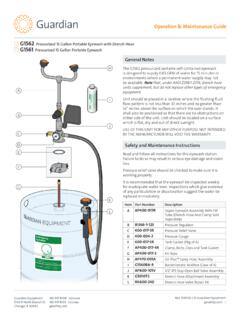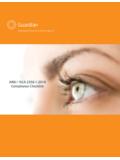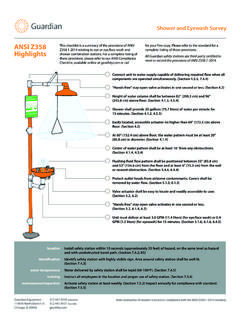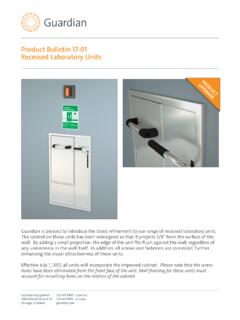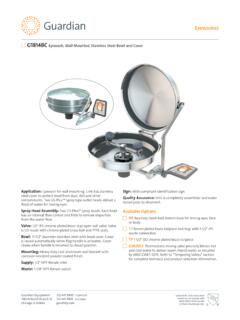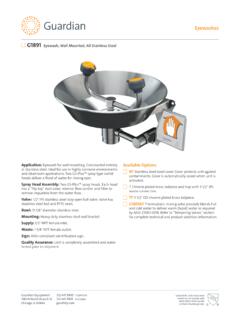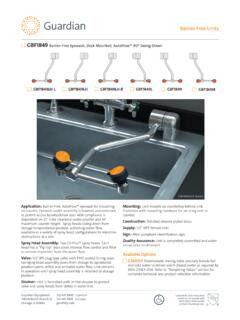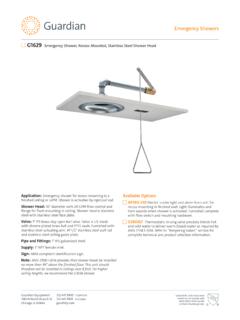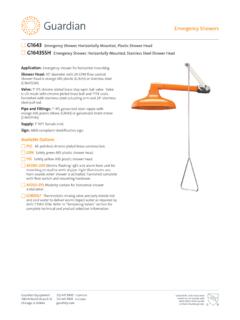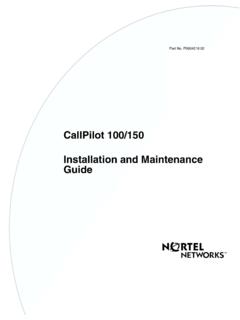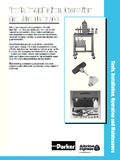Transcription of Installation, Operation and Maintenance Guide
1 Operation and Maintenance Guide : Eyewash/Drench Hose Units Drench Hose Units installation , Operation and Maintenance Guide : Eyewash/Drench Hose Units Drench Hose Units Guardian Equipment is the world's leading manufacturer of emergency eyewash and shower technology and related products for use in industrial facilities, commercial institutions, and many other applications where eye and body protection is a concern. As such, Guardian drench hose units and dual purpose eyewash/drench hose units have been installed in thousands of facilities over the past thirty years. These units are relied upon to instantly flush the user's eyes, face or body should a chemical spill occur. Like all Guardian products, our eyewash/drench hose and drench hose units are designed, engineered and manufactured for reliable performance and exceptional durability.
2 However, like all of our products, they must be installed correctly, operated properly, inspected regularly and maintained periodically to assure that they will be available when needed. This installation , Operation and Maintenance Guide will assist users and facility Maintenance personnel in these activities. Guardian Equipment 312 447 8100 TELEPHONE rev 0717 / 2017 Guardian Equipment 1140 N North Branch St 312 447 8101 FACSIMILE. Chicago, IL 60642 IOM-DH-010. Operation and Maintenance Guide : Eyewash/Drench Hose Units Drench Hose Units Application Information Drench hose units are typically installed on a countertop or a wall and are used to rinse any part of a user's eyes, face or body. These units are equipped with a single FS-Plus spray-type outlet head. As a single head unit, they cannot be used as a fixed eyewash unit, since they cannot wash both eyes simultaneously.
3 Under American National Standard for Emergency Eyewash and Shower Equipment (ANSI 2014), drench hose units support emergency eyewash and shower stations, but do not replace them. Consequently, drench hose units are intended solely as supplemental units providing additional protection, as they cannot serve as the primary means for eyewash protection. Twenty years ago, Guardian introduced the first dual purpose eyewash/drench hose unit. These units are designed to meet the provisions of ANSI as both an eyewash and a drench hose. Dual purpose eyewash/drench hose units are typically installed on a countertop next to or behind a sink. They may also be mounted on a wall. The deck flange or wall bracket positions the unit so the handle and spray heads face forward at all times. In an emergency, the user can use the unit as a fixed eyewash by squeezing the lever handle to activate the water flow.
4 A locking clip on the lever handle holds the valve open, so the user's hands are free during use. The user can lean over the unit to rinse his or her eyes. Alternatively, the user can use the unit as a drench hose by removing it from the deck flange or wall bracket and rinsing any part of his or her eyes, face or body. installation Installing Guardian eyewash/drench hose and drench hose units requires the use of common plumbing installation techniques. Observing the following guidelines will help to assure trouble-free installation : 1. The water supply line should be at least 1/2" OD and should be copper or other corrosion resistant material. 2. Deck mounted units require a 1-3/8" diameter mounting hole. The hole should be large enough to accommodate the shank on the deck flange but not permit excessive lateral movement.
5 Minimizing the hole size provides as large a surface as possible for the locknut and lockwasher to secure against. 3. Thoroughly clean and flush the supply line prior to installing unit. Pipe shavings, scale, tape and other debris can be carried through a pipe and into the unit when the system is activated. This debris can damage valve components and interfere with proper Operation of the valve. 4. Units have a 3/8" NPT male thread on the inlet. Use PTFE tape or other pipe sealant to seal this thread. Do not apply the sealant in a way that will permit it to enter into the unit. 5. Units are fully assembled and factory tested prior to shipment. Units are tagged when factory testing is complete. If a unit is received without an inspection tag, please notify the factory. 6. Clean eyewash/drench hose and drench hose units using only a soft cloth and soapy water.
6 Do not use abrasives, detergents or other cleaners that can damage the finish on the unit. Never use any cleaning agent that contains ammonia near a laboratory service fitting or emergency eyewash unit, as ammonia will aggressively corrode the brass contained in these products. In addition to observing these common plumbing installation techniques, there are several additional guidelines specific to these units that must be observed: 1. Install units with adequate clear space around them to be free of obstructions. In an emergency, units should be readily accessible to the user without interference from other equipment (such as mixing faucets, pegboards, instrumentation, etc.). Units should be installed at least 6" from the wall. 2. I nstall units so that the handle and spray heads face forward toward the user.
7 On deck mounted units, this requires installing the deck flange with the handle locator guides properly positioned. 3. O. n deck mounted units, make sure that the hose does not bind underneath the counter. In addition, there should be no sharp edges, corners or objects that can rub against the hose. The unit must be able to be removed from the deck flange without restriction or binding and the hose must pull out easily from the deck flange. On deck mounted eyewash/drench hose units, make sure that the unit is accessible from the front edge of the counter on which it is installed. rev 0717 / 2017 Guardian Equipment Guardian Equipment 312 447 8100 TELEPHONE. 1140 N North Branch St 312 447 8101 FACSIMILE. Chicago, IL 60642 2. Operation and Maintenance Guide : Eyewash/Drench Hose Units Drench Hose Units Operation The proper use of an eyewash/drench hose or drench hose unit requires observing a few simple guidelines: 1.
8 All users must be instructed as to the location of all safety equipment in the facility, including emergency eyewash and shower equipment. 2. In the event of a chemical splash or spill, the affected area of the victim's body must be flushed immediately for at least fifteen minutes. For chemical spills to the eyes, the user should hold his or her eyes open as wide as possible to permit the water to reach all areas around the eye. 3. Rinsing the affected area for fifteen minutes is only the first step in treating exposure to a hazardous chemical. Following rinsing, the victim should be examined and treated by a doctor or other trained medical specialist as soon as possible. Inspection and Maintenance Like all emergency eyewash and shower equipment, eyewash/drench hose and drench hose units must be inspected on a regular basis to assure that, in an emergency, they are available for immediate and effective use.
9 Guardian recommends that the following inspection schedule be followed for all emergency eyewash and shower equipment: Weekly Activation: In accordance with the provisions of ANSI , all emergency equipment should be activated at least weekly to assure proper Operation . Monthly Maintenance Inspection: All emergency equipment, including eyewash/drench hose and drench hose units, should be . inspected at least monthly to find and address any Maintenance issues. The monthly inspection should incorporate the recommended weekly activation of the unit, as well as a thorough inspection of the unit to assure that it is in good operating condition and showing no signs of wear. Particular attention should be paid to the spray heads, valve and hose assembly. Annual Compliance Inspection: All emergency equipment should be inspected at least annually to verify continued compliance with.
10 The provisions of ANSI Each of these inspections is described in more detail below. 1. Weekly Activation Weekly activation is a simple but effective check to make sure that the emergency equipment is in good operating condition. A record of the weekly activation should be maintained on a tag affixed to the unit. 2. Monthly Maintenance Inspection The monthly Maintenance inspection of eyewash/drench hose and drench hose units is a longer and more comprehensive inspection than the weekly activation. Listed below are the major elements that this inspection should cover. In addition, Guardian has developed the Monthly Inspection Troubleshooting Guide included below to assist in the recommended monthly inspections of eyewash/drench hose and drench hose units. Guardian Equipment 312 447 8100 TELEPHONE rev 0717 / 2017 Guardian Equipment 1140 N North Branch St 312 447 8101 FACSIMILE.
